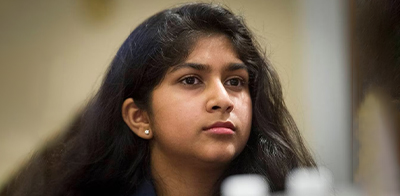(September 4, 2024) The daughter of a marine biologist, Nadia Nazar grew up seeing how climate change was harming animals. And eventually, she began to see what it was doing to people too. One thing led to another and in 2018, Nadia co-founded Zero Hour, a “youth-led international coimate justice organisation.” Soon after their founding, they organised the Youth Climate Summit, which included rallying hundreds of young people to march on Washington DC. Nadia’s efforts culminated in public officials signing a pledge to not refuse money from fossil fuel campaigns.
After the Summit’s success, Zero Hour chapters sprung up across the world, from LA to Portugal to India. Nadia and her co-founder, Jamie Margolin, are no longer strangers to testifying in Congress and Margolin even spoke alongside climate activist Greta Thunberg. In February 2019, Nadia addressed the House Natural Resources Committee Hearing on climate change, speaking about the impact of climate change in developing countries and low-income communities in the US. A talented artist, Nadia, who is currently at Maryland Institute College of Art, believes strongly in art as an effective tool for climate justice, and serves as Zero Hour’s art director.

Founding Zero Hour
Nadia was born and raised in Baltimore county and was in middle school when she first learned about climate change during an environmental science class. With her mother being a marine biologist, Nadia had already witnessed the devastation that climate change could cause and wondered what she could do to offer a solution. “It was really devastating because animals are not doing anything to cause the problem but they’re the ones being affected first,” Nadia told the Baltimore Sun.
The Youth Climate Summit
Over 100 young people stood together to deliver the No Fossil Fuel Money Pledge to elected officials, a day that Nadia still recalls with a smile. Dozens of sister marches had taken place across the US, in a highly publicised spectacle. For 14-year old Global Indian and her co-founder Jamie Margolin, who was also a high school student, Zero Hour’s first event had been a huge success.
The Zero Hour story began when Nadia first discovered Jamie Margolin, a high school student who was working on bringing more young people into the fight against climate change. Nadia reached out and the two began to work together. “I was a very goal-oriented person and I really wanted to start this youth march,” Jamie said, shortly after the summit. “When Nadia was basically the only person reaching out to me back then, consistently coming up with ideas and being proactive, I was very excited to work with her. She shared the vision that I had and so sharing everything we built together was incredible.” They saw a manifold increase in success, though and 44 chapters of Zero Hour sprung up across the US and internationally.
The Summit happened merely weeks after Zero Hour came to be. And even if Margolin was “goal-oriented,” organising a nation-wide movement was not easy. The long hours, short deadlines and the sheer intensity of purpose left the teenagers with self-doubt and burnout. “It took a toll on my mental health,” Nadia said. “I only really started taking care of my mental health when COVID started because I finally had the time. Learning how to sleep every day made a difference.”
View this post on Instagram
Making sacrifices for a cause
However, Nadia Nazar admits that her life is drastically different from that of her peers. She sacrifices the parties, the travelling and many of the little things that are part of the high school experience. “They are hard choices to make but I make them for a reason,” she says. During Covid, she went back to the self-care basics. “None of us really prioritised rest. You would go to school, come home and do homework and then stay up all night working after that. It was not healthy for any of us. It was draining and it made the work so much harder.”
Art for climate justice
“Anyone can understand art especially if you don’t have words to communicate,” says Nadia, who had always been interested in art and painting. Now, she sees art as a highly effective tool for change, and to spread awareness. “I think it’s so important that we also talk about the emotional aspect of climate change… let’s tell the stories of how people are being affected – the anger, the anxiousness and the grief. Art has been a really good tool for that.”
Follow Nadia Nazar on Instagram.




